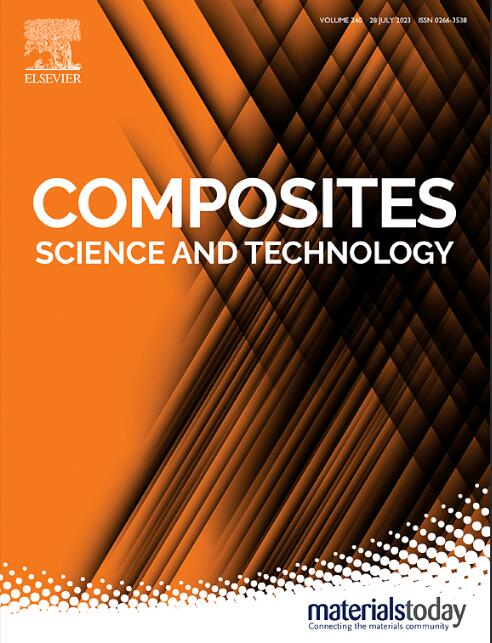聚酰胺6/环烯烃共聚物/碳纤维复合材料在准静态、冲击和疲劳条件下的自修复
IF 8.3
1区 材料科学
Q1 MATERIALS SCIENCE, COMPOSITES
引用次数: 0
摘要
本研究研究了含环烯烃共聚物(COC)作为愈合剂和不连续碳纤维(CF)增强剂的聚酰胺6 (PA6)复合材料在准静态、冲击和疲劳载荷条件下的自修复能力。为此,通过熔融复合和注射成型制备了PA6/COC (30 wt%)/CF (20 wt%)复合材料。将COC复合材料的微观结构、力学性能和自修复性能与参考PA6/CF (20% wt%)的复合材料进行比较。COC的加入虽然略微降低了准静态力学性能,但显著提高了抗冲击性能。COC结构域的存在使冲击测试中的愈合效率(HE)高达80%,而在准静态断裂测试中,由于基体塑化阻碍了COC在断裂带中的流动,HE值较低。值得注意的是,疲劳测试表明,PA6/COC/CF复合材料在热修补过程中具有修复微损伤的能力,其自身的疲劳寿命延长了77%,而原始样品则无法愈合。这些结果突出了固有自修复热塑性复合材料在延长结构复合材料使用寿命方面的潜力,特别是在循环加载条件下。本文章由计算机程序翻译,如有差异,请以英文原文为准。

Self-healing of polyamide 6/cyclic olefin copolymer/carbon fiber composites under quasi-static, impact, and fatigue conditions
This study investigates the self-healing capabilities of polyamide 6 (PA6) composites containing a cyclic olefin copolymer (COC) as a healing agent and a discontinuous carbon fiber (CF) reinforcement under quasi-static, impact, and fatigue loading conditions. To this aim, PA6/COC (30 wt%)/CF (20 wt%) composites were prepared via melt-compounding and injection molding. The microstructure, mechanical properties, and self-healing behavior of the composites with COC were compared with those of the reference PA6/CF (20 wt%). Although the addition of COC slightly reduces the quasi-static mechanical properties, it significantly improves the impact resistance. The presence of COC domains allow healing efficiencies (HE) of up to 80 % in impact tests, whereas lower HE values are found in quasi-static fracture tests owing to matrix plasticization hindering the COC flow in the fracture zone. Notably, fatigue testing reveals the ability of PA6/COC/CF composites to repair microdamage during thermal mending, extending their own fatigue life by 77 %, while virgin samples are not able to heal. These results highlight the potential of intrinsic self-healing thermoplastic composites to extend the service life of structural composites, particularly under cyclic loading conditions.
求助全文
通过发布文献求助,成功后即可免费获取论文全文。
去求助
来源期刊

Composites Science and Technology
工程技术-材料科学:复合
CiteScore
16.20
自引率
9.90%
发文量
611
审稿时长
33 days
期刊介绍:
Composites Science and Technology publishes refereed original articles on the fundamental and applied science of engineering composites. The focus of this journal is on polymeric matrix composites with reinforcements/fillers ranging from nano- to macro-scale. CSTE encourages manuscripts reporting unique, innovative contributions to the physics, chemistry, materials science and applied mechanics aspects of advanced composites.
Besides traditional fiber reinforced composites, novel composites with significant potential for engineering applications are encouraged.
 求助内容:
求助内容: 应助结果提醒方式:
应助结果提醒方式:


